Welcome to the wild world of Michigan’s slithery inhabitants! Michigan, known for its beautiful Great Lakes and picturesque landscapes, is also home to a diverse range of snake species. Therefore, it’s essential to understand and respect their habitats to ensure the safety of both humans and snakes while promoting conservation efforts.
In this article, we’ll be taking you on an exciting journey to explore some of the most snake-infested lakes in Michigan. We’ll dive into the fascinating world of water snakes and learn about their habitats and behaviors. Additionally, we’ll touch on other animals that share these lake ecosystems, and we’ll share some essential safety tips for when you find yourself near these lakes.
So, buckle up and join us as we venture into Michigan’s snake-infested lakes and learn how to coexist with these remarkable creatures.
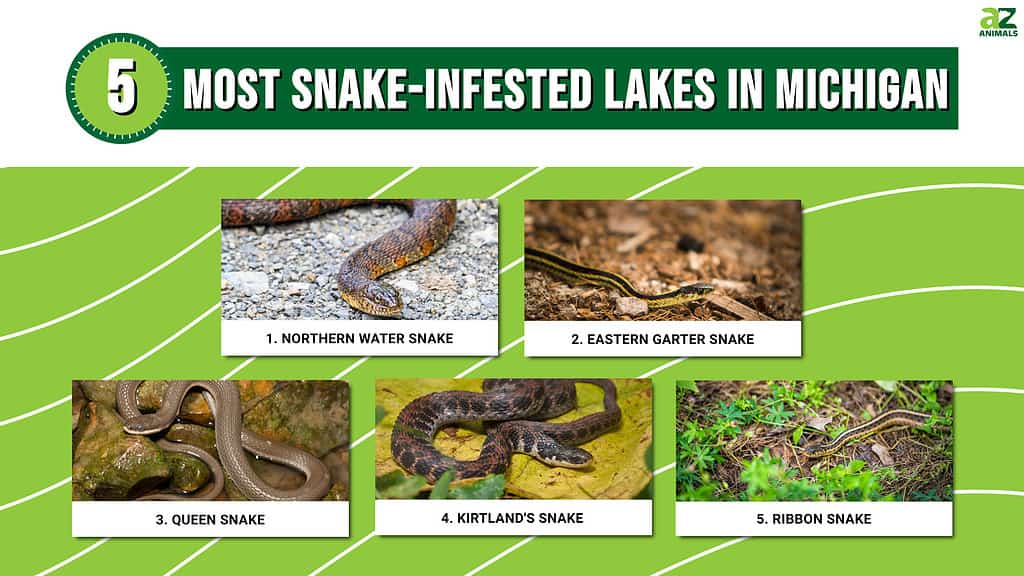
Ribbon snakes are non-venomous, excellent swimmers and are often seen darting through the water in pursuit of prey.
©
Water Snakes Found In Michigan Lakes
Michigan’s lakes are home to an astounding array of water snakes, each with their unique characteristics and behaviors. In this section, we will introduce five common water snake species found in Michigan’s lakes, providing you with fascinating insights into their habitats, diets, distinguishing features, and reproductive behaviors.
1. Northern Water Snake (Nerodia sipedon)
This is one of the most common snakes found in Michigan’s lakes. These non-venomous snakes have dark bands on their bodies and can grow up to 4 feet in length. They are excellent swimmers and can often be found basking on rocks or branches near the water’s edge.
Northern water snakes feed on fish, frogs, and other small aquatic creatures, using their sharp teeth to grab onto slippery prey. Then, they give birth to live young, with females producing up to 30 offspring at a time.
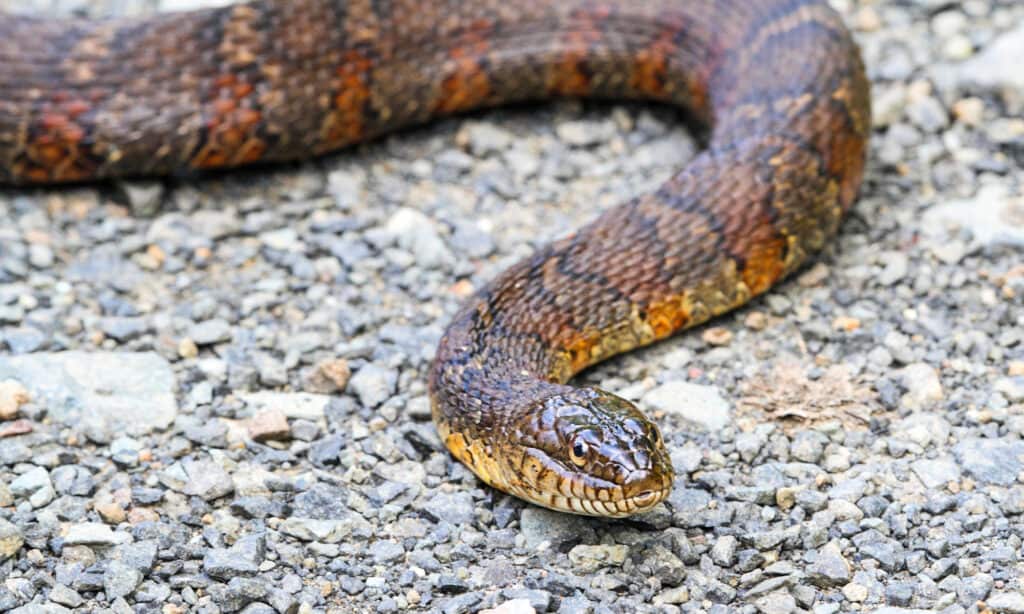
The northern water snake is one of the most common snakes found in Michigan’s lakes.
©Steve Byland/Shutterstock.com
2. Eastern Garter Snake (Thamnophis sirtalis)
These snakes are often found near water sources, including lakes, ponds, and rivers. Although not strictly aquatic, they are skilled swimmers and will take to the water in search of prey or to escape predators. Their diet consists of amphibians, fish, and invertebrates, such as earthworms and slugs.
Eastern garter snakes are easily recognized by the three longitudinal stripes running along their bodies. They give birth to live young, with females producing up to 50 offspring in a single litter.
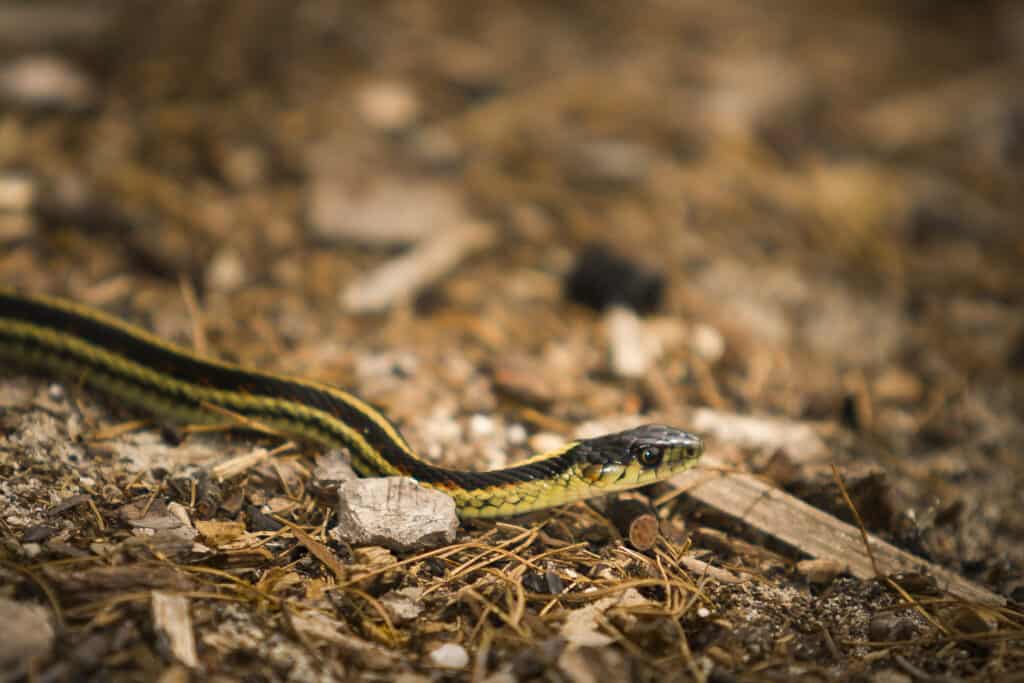
The eastern garter snake can be identified by the three longitudinal stripes running along its body.
©iStock.com/SolomonCrowe
3. Queen Snake (Regina septemvittata)
Queen snakes are another water snake species found in Michigan‘s lakes. These smaller, non-venomous snakes grow up to 2 feet in length and have a dark stripe running down each side of their body.
Queen snakes are highly specialized feeders, primarily consuming freshly molted crayfish, which are softer and easier to digest. In addition, they prefer clean, clear waters with an abundance of rocky cover to hunt for their preferred prey. Queen snakes give birth to live young, with females producing up to 20 offspring at a time.
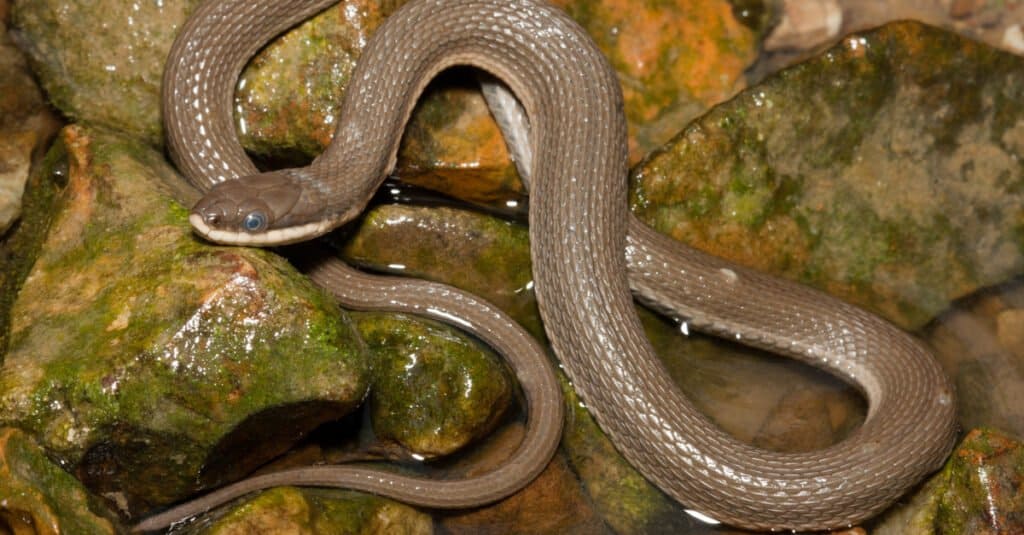
Queen snakes prefer clean, clear waters with an abundance of rocky cover to hunt for their preferred prey.
©Nathan A Shepard/Shutterstock.com
4. Kirtland’s Snake (Clonophis kirtlandii)
This small and secretive species is often found near wetlands and shallow lakes. Measuring up to 2 feet in length, this non-venomous snake is characterized by its reddish-brown coloration and a distinct row of black spots along each side of its body.
Kirtland’s snake primarily feeds on earthworms and slugs, using its secretive nature and excellent camouflage to ambush prey. Unlike the other species mentioned here, Kirtland’s snake is oviparous, meaning it lays eggs. Females lay up to 20 eggs in a single clutch, usually in damp, protected areas.

Kirtland’s snake has a reddish-brown coloration and a distinct row of black spots along each side of its body.
©Mike Wilhelm/Shutterstock.com
5. Ribbon Snake (Thamnophis sauritus)
Ribbon snakes are slender, non-venomous snakes that inhabit wetland areas, including the shores of Michigan’s lakes. They can grow up to 3 feet in length and have three bright yellow stripes running along their dark-colored bodies.
Ribbon snakes are excellent swimmers and are often seen darting through the water in pursuit of prey. They feed on amphibians, fish, and invertebrates, using their quick reflexes and keen eyesight to catch their meals. Ribbon snakes give birth to live young, with females producing up to 26 offspring in a single litter.
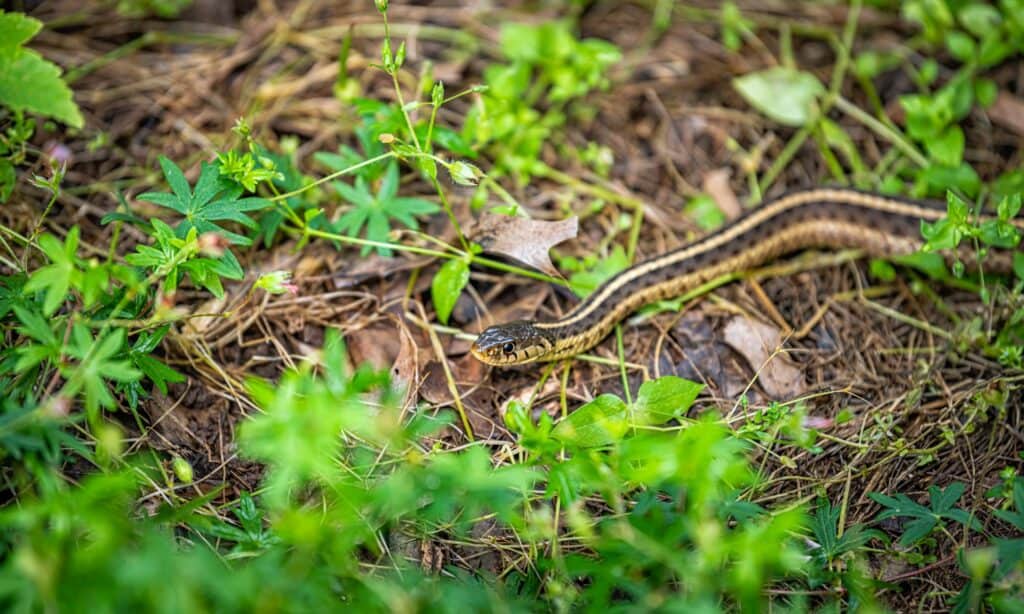
Ribbon snakes can be found along the shores of Michigan’s lakes.
©iStock.com/krblokhin
Top Snake-Infested Lakes In Michigan
Michigan’s lakes offer an incredible array of natural beauty and a surprising variety of snake species. In this section, we’ll explore some of the most snake-infested lakes in the state, delving into what makes each one unique and why they are popular spots for our slithery friends. In addition, we’ll provide more details about each lake’s ecosystem and the specific snakes that can be found in these picturesque locations.
1. Lake St. Clair
Situated between Lake Erie and Lake Huron, Lake St. Clair covers an area of about 430 square miles and is home to numerous islands and marshy areas. Its extensive shoreline, marshes, and wetlands provide the perfect habitat for the Eastern garter snake and the northern water snake.
The northern water snake is known to give live birth in the shallows, while the eastern garter snake enjoys the abundant amphibian population for its diet. Be cautious when exploring the area, but also take the time to appreciate the fascinating ecosystem that supports these beautiful creatures.

Lake St. Clair’s extensive shoreline, marshes, and wetlands provide the perfect habitat for the eastern garter snake and the northern water snake.
©Dave Bosen/Shutterstock.com
2. Houghton Lake
As Michigan’s largest inland lake, this lake spans over 20,000 acres and offers an abundance of food and shelter for snakes. The queen snake is a frequent visitor to this lake, feasting on the plentiful crayfish population, which comprises up to 90% of their diet.
Houghton Lake’s numerous inlets and coves, such as Backus Creek and Lake James, provide the ideal environment for these snakes to thrive. So keep an eye out for them, sunning themselves on rocks or slithering through the shallows.

The queen snake can often be found feasting on Houghton Lake’s plentiful crayfish.
©HoverSolutions/Shutterstock.com
3. Lake Fenton
Lake Fenton, located in Genesee County, covers about 845 acres and boasts a healthy snake population due to its lush shoreline vegetation and surrounding wetlands. In addition, the lake’s shallow waters and ample hiding spots, such as the numerous docks and piers, make it a prime location for both northern water snakes and eastern garter snakes. These snakes can often be spotted basking in the sun or swimming near the surface in search of prey, such as small fish and frogs.
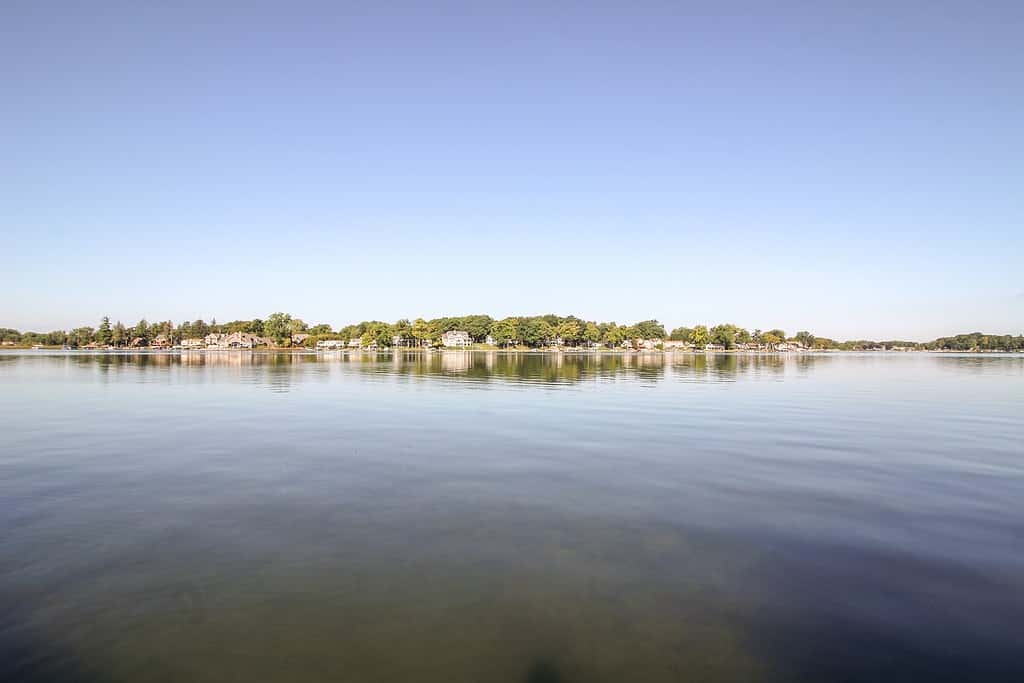
Lake Fenton has lush shoreline vegetation and surrounding wetlands which create an ideal home for many snake species.
©Tiffany Taljonick/Shutterstock.com
4. Lake Orion
Nestled in Oakland County, Lake Orion spans 470 acres and is surrounded by dense forests and wetlands, creating a perfect habitat for a variety of snake species. The eastern massasauga rattlesnake can sometimes be found near the lake’s marshy edges, particularly in areas with tall grasses or under fallen trees. Be vigilant when exploring the area, and make sure you’re familiar with how to identify and avoid this venomous species.

The venomous eastern massasauga rattlesnake can sometimes be found near Lake Orion’s marshy edges.
©Ryan M. Bolton/Shutterstock.com
5. Long Lake
Located in Grand Traverse County, Long Lake covers 2,860 acres and features diverse habitats, including marshy areas, sandy beaches, and wooded shorelines. These conditions make it an attractive home for northern water snakes, eastern garter snakes, and even the elusive eastern massasauga rattlesnake. The lake’s five islands, such as Picnic Island and Long Island, provide additional havens for these species. Always be cautious and respectful when exploring these beautiful natural spaces.
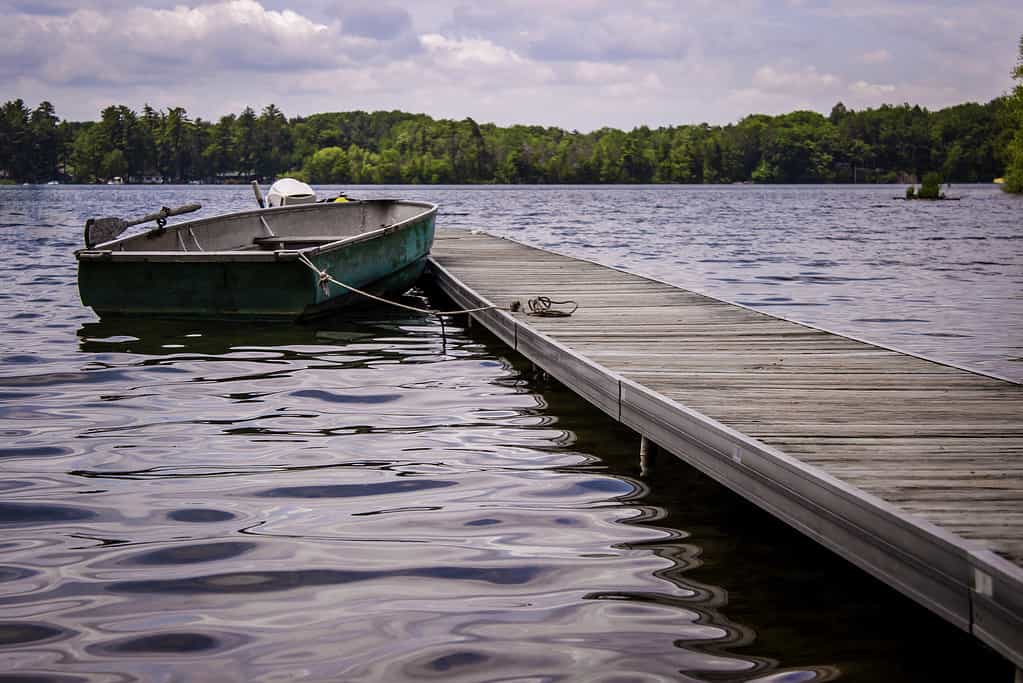
Long Lake covers 2,860 acres and features diverse habitats, including marshy areas, sandy beaches, and wooded shorelines.
©iStock.com/CharlieTurchetta
Other Animals Found In And Around Michigan Lakes
Michigan’s lakes are not only famous for their snake populations, but they also host a diverse array of other incredible creatures. In this section, we’ll explore some of the fascinating animals you might encounter while spending time around these beautiful lakes.
Mammals
Beavers are some of the most recognizable and industrious creatures you’ll find near Michigan’s lakes. They’re known for their dam-building skills, which create new habitats for numerous other species. Muskrats also thrive in these environments, swimming effortlessly and feeding on aquatic plants. And don’t be surprised to spot a white-tailed deer gracefully drinking water at the edge of the lake.
Birds
Bird enthusiasts will be delighted by the variety of avian species found around Michigan’s lakes. Keep an eye out for majestic bald eagles soaring overhead or great blue herons wading through the shallows in search of a meal. And don’t forget to listen for the haunting call of the common loon, an unmistakable soundtrack of Michigan’s lake country.
Reptiles
In addition to the snakes we’ve already discussed, Michigan’s lakes are home to other reptiles, such as painted turtles. These colorful creatures can often be seen basking on logs and rocks, enjoying the sunshine. The eastern massasauga rattlesnake, the state’s only venomous snake, prefers the wetland habitats near lakes as well.
Amphibians
Michigan’s lakes are a haven for amphibians like green frogs, whose distinctive “gunk” call is a familiar sound near the water. Salamanders also thrive in these wet environments, hiding under rocks and logs near the shoreline.
Fish
Michigan’s lakes are teeming with fish species such as walleye, largemouth bass, and yellow perch. These fish not only provide excellent recreational opportunities for anglers, but they also serve as a critical food source for many other lake-dwelling animals.
Insects
Last but not least, Michigan’s lakes are home to an array of fascinating insects. Dragonflies and damselflies dart through the air, their iridescent wings catching the sunlight. Aquatic beetles scuttle across the water’s surface, while delicate mayflies emerge in swarms for their brief adult lives.
Safety Tips For Visiting Snake-Infested Lakes
While exploring Michigan’s snake-infested lakes can be a thrilling experience, it’s essential to prioritize safety when venturing into these areas. By following some simple guidelines, you can ensure that both you and the snakes remain unharmed. In this section, we’ll share some valuable safety tips to help you enjoy these incredible ecosystems while keeping yourself and the wildlife safe.
Identify Venomous and Non-Venomous Snakes
Before you set out on your adventure, it’s crucial to know how to distinguish venomous snakes from non-venomous ones. The eastern Massasauga rattlesnake is the only venomous snake in Michigan, and it can be identified by its triangular head, vertical pupils, and distinctive rattle at the end of its tail. Non-venomous snakes, such as the northern water snake and eastern garter snake, have round pupils and a more streamlined head shape.
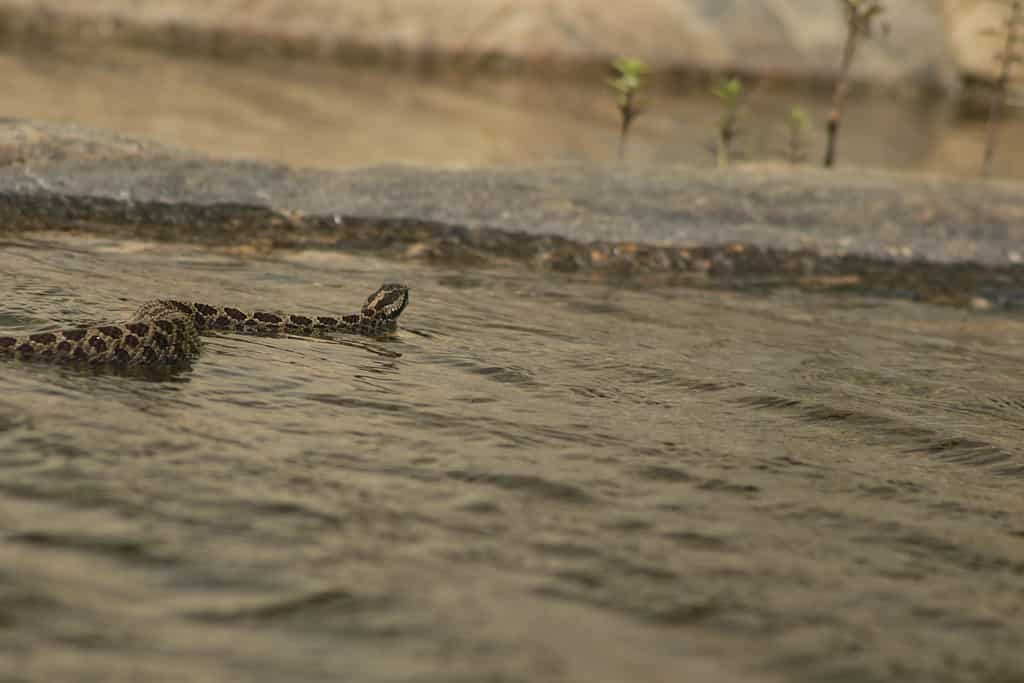
Always keep a safe distance (at least six feet) from any snake you encounter in Michigan’s lakes.
©mynewturtle/Shutterstock.com
Appropriate Behavior around Snakes
Respecting the snakes’ personal space is key to avoiding unwanted encounters. Always keep a safe distance (at least six feet) from any snake you encounter, and avoid attempting to touch, handle, or capture them. Snakes are generally not aggressive towards humans unless they feel threatened, so it’s best to observe from a distance and let them go about their business.
First Aid and Treatment for Snakebites
In the unlikely event of a snakebite, it’s essential to know the proper first aid steps. For non-venomous snakebites, follow this procedure:
- Step 1: Clean the wound with soap and water
- Step 2: Apply an antibiotic ointment
- Step 3: Cover it with a clean, dry bandage
For a venomous snakebite, the following steps may save a life:
- Step 1: Remain as calm and still as possible
- Step 2: Remove any tight clothing or jewelry near the bite
- Step 3: Seek immediate medical attention
Note: Do not attempt to suck out the venom, apply ice, or use a tourniquet.
Preserving the Natural Habitat
Respecting and preserving the natural habitat is crucial for the well-being of the snakes and other wildlife. Stick to established trails when hiking, and avoid disturbing the vegetation or turning over rocks and logs where snakes might be hiding. Leave the area as you found it, and avoid littering or introducing foreign substances into the environment.
Key Takeaways
Well, we’ve reached the end of our adventure through Michigan’s snake-infested lakes. We’ve discovered some fascinating water snakes, the lakes they call home, and the other creatures that share these beautiful ecosystems.
Understanding and respecting snake habitats is vital to promoting a harmonious relationship between humans, snakes, and the environment. By being aware of the balance between recreation and conservation, we can all contribute to the protection and preservation of these incredible ecosystems.
Remember to keep our handy safety tips in mind when you venture near these lakes and don’t forget that responsible interaction with wildlife is key to ensuring a healthy environment for everyone.
Now that you’re armed with this knowledge, you’re ready to explore Michigan’s lakes with confidence, curiosity, and a newfound appreciation for the snakes that call them home.
The photo featured at the top of this post is © Philip Yabut/Shutterstock.com
Thank you for reading! Have some feedback for us? Contact the AZ Animals editorial team.






